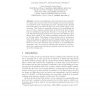KR
2010
Springer
14 years 11 months ago
2010
Springer
We show that linear logic can serve as an expressive framework in which to model a rich variety of combinatorial auction mechanisms. Due to its resource-sensitive nature, linear l...
CIE
2010
Springer
14 years 11 months ago
2010
Springer
Game semantics provides an interactive point of view on proofs, which enables one to describe precisely their dynamical behavior during cut elimination, by considering formulas as ...
ICTCS
2003
Springer
14 years 11 months ago
2003
Springer
Abstract. Given two proofs in a logical system with a confluent cutelimination procedure, the cut-elimination problem (CEP) is to decide whether these proofs reduce to the same no...
GCC
2003
Springer
14 years 11 months ago
2003
Springer
This paper introduces a method for automatic composition of semantic web services using linear logic theorem proving. The method uses semantic web service language (DAML-S) for ext...
LICS
2003
IEEE
14 years 11 months ago
2003
IEEE
We show that the decomposition of Intuitionistic Logic into Linear Logic along the equation ´ may be adapted into a decomposition of classical logic into LLP, the polarized versi...
ICALP
2004
Springer
14 years 11 months ago
2004
Springer
We consider the multiplicative and exponential fragment of linear logic (MELL) and give a Geometry of Interaction (GoI) semantics for it based on unique decomposition categories. ...
FOSSACS
2004
Springer
14 years 11 months ago
2004
Springer
Soft linear logic ([Lafont02]) is a subsystem of linear logic characterizing the class PTIME. We introduce Soft lambda-calculus as a calculus typable in the intuitionistic and affi...
CSL
2005
Springer
14 years 11 months ago
2005
Springer
Recent work establishes a direct link between the complexity of a linear logic proof in terms of the exchange rule and the topological complexity of its corresponding proof net, ex...
WOLLIC
2007
Springer
15 years 10 days ago
2007
Springer
We survey several computational interpretations of classical linear logic based on two-player one-move games. The moves of the games are higherorder functionals in the language of ...
LPAR
2007
Springer
15 years 11 days ago
2007
Springer
Abstract. Permutative logic (PL) is a noncommutative variant of multiplicative linear logic (MLL) arising from recent investigations concerning the topology of linear proofs. Permu...





